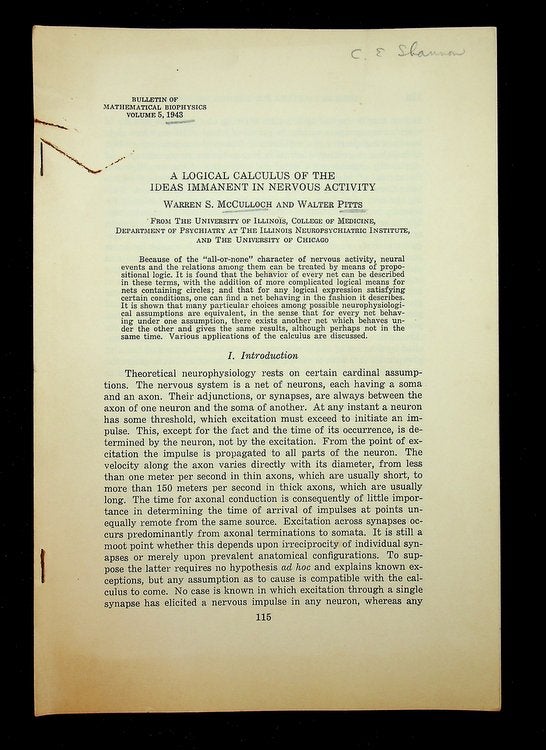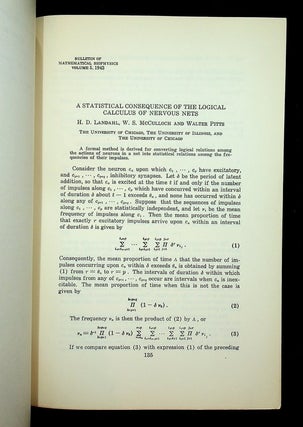A Logical Calculus of the Ideas Immanent in Nervous Activity WITH A statistical consequence of the logical calculus of nervous nets
[ Chicago, Ill.]: [ The University of Chicago Press ] 1943. First Separate Edition. Two offprints stapled together. Logical Calculus: 115-133, [1-blank] pages WITH Statistical Consequence: 135-137,[1-blank] pages. Both are very rare offprints from the Bulletin of Mathematical Biophysics 5 (1943). Front page SIGNED in pencil by scientist Claude E. Shannon ("C.E. Shannon") and from his personal library. 6 3/4 x 10 inches. Trimmed at the spine and restapled with small loss to margins but not affecting text (normally 6 7/8 wide). Staples rusty, with old paper clip mark upper left. Light soiling, some pencil underlining. A few soil spots internally. Very Good. Wraps. [28155]
"McCulloch and Pitts's paper contains THE FIRST MATHEMATICAL MODEL OF NEURAL NETWORKS. Based on an amalgam of Carnap's logical calculus and Russell and Whitehead's 'Principia Mathematica', the paper presented a logical model of neuron nets, showing their functional similarity to Turing's universal machines. Published in a relatively obscure journal, the paper was generally ignored until it came to the notice of John von Neumann, author of the pioneering theory of the stored-program electronic computer (First Draft of a Report on the EDVAC [1945]). Von Neumann was the first to realize that the switches of a stored-program computer could be described in McCulloch and Pitts notation. This observation led him to the logical equivalence of finite nets and the state tables and delays describing Turing machines.
'A logical calculus of the ideas immanent in nervous activity' was a collaboration of two extraordinary individuals. McCulloch majored in philosophy and psychology at Haverford and Yale, earned a master's degree at Columbia in psychology for work in experimental aesthetics, and received his M.D. at Columbia Medical School, where he studied the physiology of the nervous system. He worked at Bellevue and Rockland State Hospital for the Insane, returned to Yale where he worked with the neurologist Dusser de Barenne, then left Yale for the University of Illinois at Chicago where he came into contact with Walter Pitts. An autodidact without a high school or college degree, Pitts had nevertheless studied mathematical logic under Carnap at Chicago and was a highly original mathematical logician. After the two wrote this paper, Pitts moved to the Research Laboratory of Electronics at MIT, where he collaborated with Norbert Wiener and others. McCulloch followed him to MIT in 1952. While Pitts may have been a typical scholarly introvert, McCulloch was extroverted and dramatic in his appearance and his language..." (Origins of Cyberspace)
"As von Neumann emphasized in his 'General and Logical Theory of Automata' (1951), the essence of McCulloch and Pitts's contribution was to show how any function of the brain that could be described clearly and unambiguously in a finite number of words could be expressed as one of their formal neuron nets. The close relationship between Turing machines and neuron nets was one of the goals of the authors; by 1945 they understood that neuron nets, when supplied with an appropriate analog of Turing's infinite tape, were equivalent to Turing machines. With Turing machines providing an abstract characterization of thinking in the machine world and McCulloch and Pitts's neuron nets providing one the biological world, the equivalence result suggested a unified theory of thought that broke down barriers between the physical and biological worlds. Their paper not only pointed out the similarity in abstraction function between the human brain and computing devices; it also provided a way of conceiving of the brain as a machine in a more precise way than had been available before. It provided a means for further study of the brain, starting from a precise mathematical formulation." (Aspray, The Scientific Conceptualization of Information, Annals of the History of Computing 7 [1985], 130.)
Literature: Hook and Norman, "Origins of Cyberspace", #784. Aspray, "The Scientific Conceptualization of Information, Annals of the History of Computing 7 [1985]" p. 130.
Very rare. The last copy sold at auction (for 7200) was at the 2005 Origins of Cyberspace sale. This example includes the follow-on paper not present in there and is SIGNED by Claude Shannon the father of information theory.
Provenance: From the files of Claude E. Shannon (signed in pencil on front cover).
NOTE: Publisher and location from OCLC/Worldcat.
ITEM SOLD



